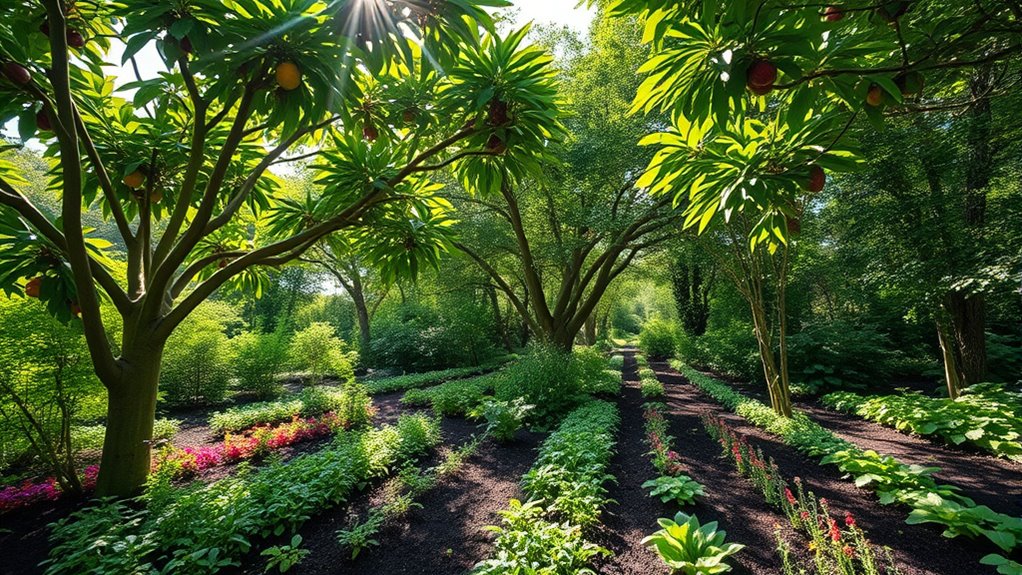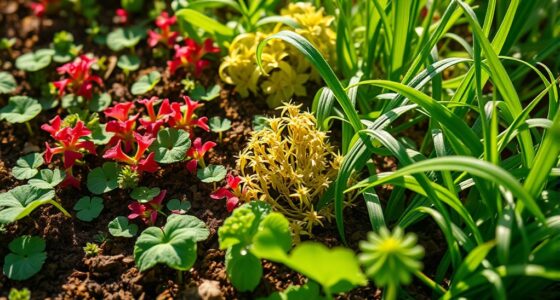To create a food forest guild for self-sustaining abundance, you should mimic natural ecosystems by selecting diverse, native plants that support pollinators, beneficial insects, and soil health. Use layered planting strategies to maximize space and resilience, incorporate organic amendments, and manage water efficiently with rain catchment and mulching. Regularly monitor, prune, and adapt your system to maintain balance. Exploring these strategies further can help you design a thriving, low-maintenance food forest that sustains itself over time.
Key Takeaways
- Mimic natural ecosystems with diverse plant layers to enhance resilience, productivity, and habitat complexity.
- Incorporate organic soil amendments, mulching, and cover crops to improve soil health and water retention.
- Use companion planting and native species to strengthen ecosystem resilience and support beneficial insects.
- Design guilds that maximize space, sunlight, and microclimate benefits for long-term sustainability.
- Practice adaptive management, including natural pest control and plant propagation, to maintain system health and productivity.
Understanding the Concept of Food Forest Guilds
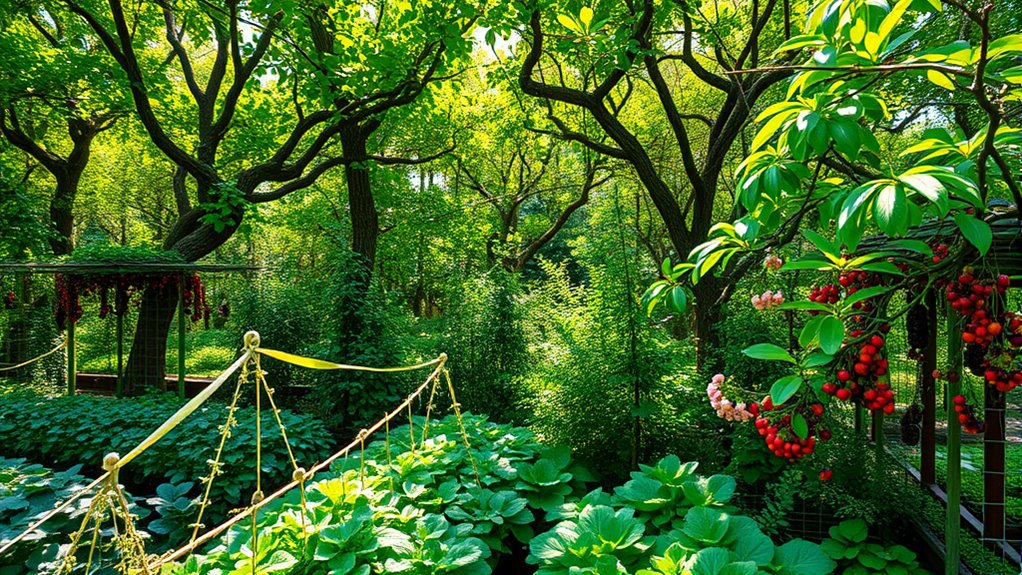
Food forest guilds are intentional plant communities designed to mimic natural ecosystems while providing food and other resources. By integrating diverse plants, you create a resilient environment that supports wildlife corridors, allowing animals to move safely through your space. This movement encourages natural pest management, as predators like birds and beneficial insects can thrive and control pests naturally. When designing your guild, consider layering plants to attract different species and provide habitats for beneficial creatures. The diversity also helps break pest cycles and reduces the need for chemical interventions. Your goal is to foster a balanced ecosystem where plants, animals, and insects work together, ensuring a self-sustaining system that offers abundant harvests with minimal effort.
Key Principles for Designing a Resilient Guild

Designing a resilient food forest guild requires applying core principles that guarantee stability and productivity over time. Focus on diversity to support pest management naturally, reducing the need for chemicals. Incorporate plants with different growth habits to promote healthy plant propagation and improve soil health. Balance sun and shade, ensuring each plant’s needs are met. Companion planting encourages beneficial relationships, enhancing resilience. Use the table below to visualize key principles:
| Principle | Application |
|---|---|
| Diversity | Mix species to prevent pests and diseases |
| Plant Propagation | Use cuttings, seeds, and layering for sustainable growth |
| Pest Management | Rely on plant diversity and natural predators |
| Balance and Spacing | Reduce competition, improve airflow and health |
Applying these principles creates a resilient, productive guild that sustains itself. Understanding plant diversity is crucial for long-term success in a food forest. Additionally, selecting plants that support each other’s growth can further enhance the guild’s resilience and productivity over time.
Selecting Appropriate Plants for Your Ecosystem
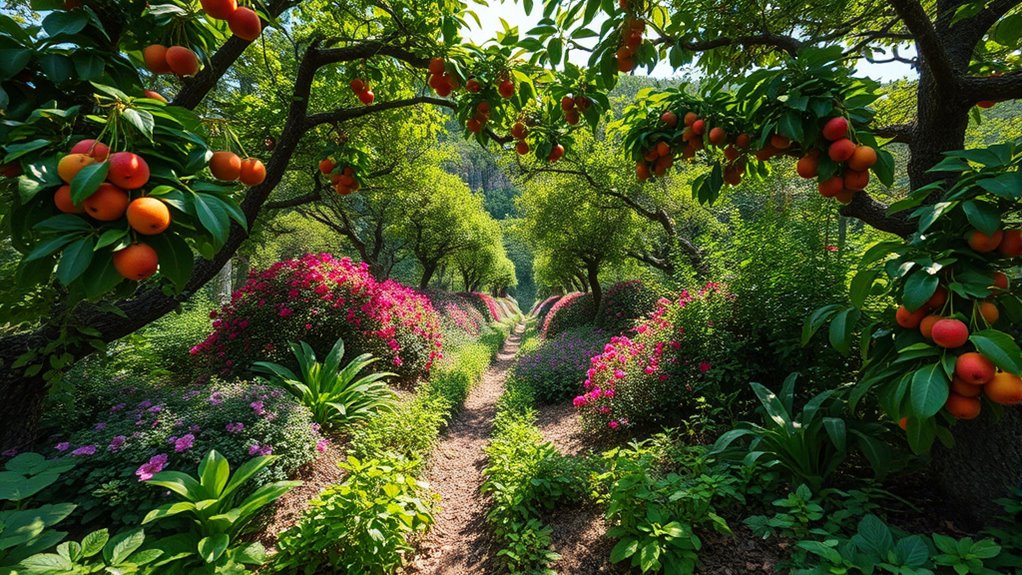
Choosing the right plants for your ecosystem is essential to creating a resilient and productive food forest. Focus on selecting species that support pollinator activity, ensuring your trees and crops are effectively pollinated. Incorporate plants that attract bees, butterflies, and other beneficial insects, which help boost yields naturally. Edible weeds are also valuable; they often grow easily, improve soil health, and provide additional food sources. These resilient plants can fill gaps and reduce maintenance, contributing to a self-sustaining system. Be mindful of native species, as they adapt better to local conditions and require less input. Additionally, using modern fixtures can enhance water efficiency and reduce resource consumption in your garden infrastructure. Understanding ecological balance is crucial for maintaining a sustainable and resilient food forest, ensuring long-term productivity. Promoting biodiversity within your ecosystem further strengthens its resilience against pests and environmental stressors. Incorporating native plant species can further increase the system’s resilience and compatibility with local environmental conditions. Integrating plant diversity supports a more stable and robust ecosystem, reducing dependency on external inputs.
Layering Strategies to Maximize Space and Productivity

Implementing layering strategies is key to maximizing space and boosting productivity in your food forest. By stacking different plant layers—canopy, understory, shrubs, herbs, and groundcovers—you create a diverse, resilient system. Companion planting enhances these layers, encouraging beneficial interactions that improve growth and yield. This technique also supports soil health by promoting diverse root systems and organic matter accumulation. Additionally, incorporating perennial plants can contribute to long-term stability and reduce the need for replanting. Employing plant diversity further enhances ecosystem resilience by attracting a variety of pollinators and beneficial insects. This diversity also helps create a more balanced microclimate, which can protect plants from extreme weather. For example, planting pest-repellent herbs beneath fruit trees can protect your crops naturally. Proper layering ensures each plant occupies its ideal space and height, minimizing competition and maximizing sunlight capture. Integrating organic matter through mulching and composting further sustains soil fertility and plant health. Overall, layering turns your food forest into a self-sustaining, productive ecosystem that uses space efficiently while naturally managing pests through strategic plant combinations.
Building Soil Health and Nutrient Cycles Naturally
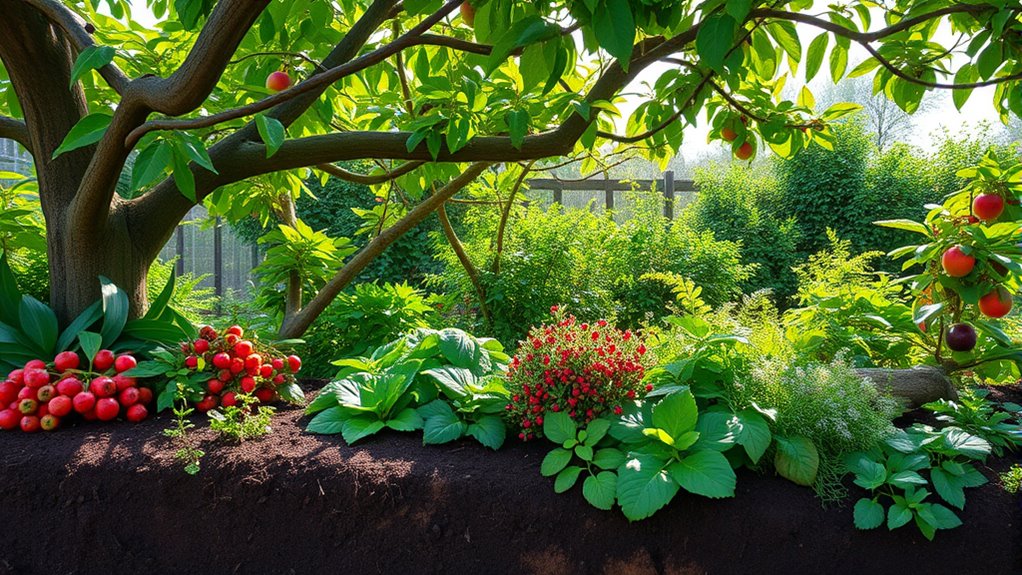
You can improve your soil’s health by using composting and mulching to add nutrients and retain moisture. Incorporating cover crops helps fix nitrogen and protect the soil from erosion. Organic soil amendments further boost fertility, creating a thriving environment for your food forest to flourish.
Composting and Mulching
Composting and mulching are essential practices for building healthy soil and maintaining nutrient cycles naturally. They help improve soil structure, retain moisture, and suppress weeds. To get started, explore these key aspects: 1. Use effective composting techniques like hot composting or worm bins to quickly break down organic waste. 2. Choose mulching materials such as straw, wood chips, or leaf litter to protect soil and add organic matter. 3. Regularly add kitchen scraps and yard waste to your compost pile, balancing greens and browns for efficient decomposition. 4. Spread mulch around plants to conserve moisture, regulate temperature, and gradually enrich the soil as it decomposes. Incorporating natural materials like wood chips and straw can enhance the soil’s health and align with sustainable practices. Additionally, understanding the importance of soil biology can further improve composting and mulching outcomes by promoting beneficial microorganisms that aid nutrient cycling.
Cover Crops Benefits
Cover crops are a powerful tool for enhancing soil health and supporting natural nutrient cycles in your food forest. By planting a diverse mix of cover crop species, you promote soil improvement through improved structure, aeration, and organic matter. Cover crop diversity ensures beneficial root systems and microbial activity, which naturally fix nitrogen and break down compaction. These plants also suppress weeds and reduce erosion, maintaining soil stability. As they grow, cover crops add biomass that feeds soil organisms, fostering a vibrant underground ecosystem. This natural process diminishes the need for synthetic fertilizers and chemical inputs. Incorporating a variety of cover crops creates a resilient, self-sustaining system that builds fertile soil over time, supporting the long-term productivity of your food forest. Soil health plays a crucial role in the overall success of your garden by improving nutrient availability and plant vitality, especially as microbial activity helps sustain nutrient cycling naturally. Additionally, diverse cover crops encourage a broad range of beneficial soil microbes, which enhances nutrient cycling and overall soil resilience.
Organic Soil Amendments
Have you considered how organic soil amendments can naturally boost the health of your food forest? They enrich soil fertility, support beneficial microbes, and improve nutrient cycles. Healthy soil encourages diverse pollination strategies by attracting native pollinators, which boosts fruit set. It also fosters a balanced ecosystem that naturally manages pests, reducing the need for chemicals. To enhance your soil, consider:
- Compost and aged manure for organic matter
- Bone meal or rock phosphate for phosphorus
- Seaweed extracts for micronutrients and growth stimulation
- Cover crop residues to fix nitrogen and suppress weeds
Using these amendments encourages a resilient, self-sustaining system, improving plant health and productivity while supporting pollinators and pest management naturally. Additionally, understanding risk assessment for merchant services can help you protect your investment in organic soil enhancements and ensure seamless transactions for your produce and supplies. Incorporating soil health principles can further optimize your efforts by fostering a thriving, balanced ecosystem, which relies on beneficial microbes to maintain nutrient availability and soil structure.
Integrating Water Management for Sustainability
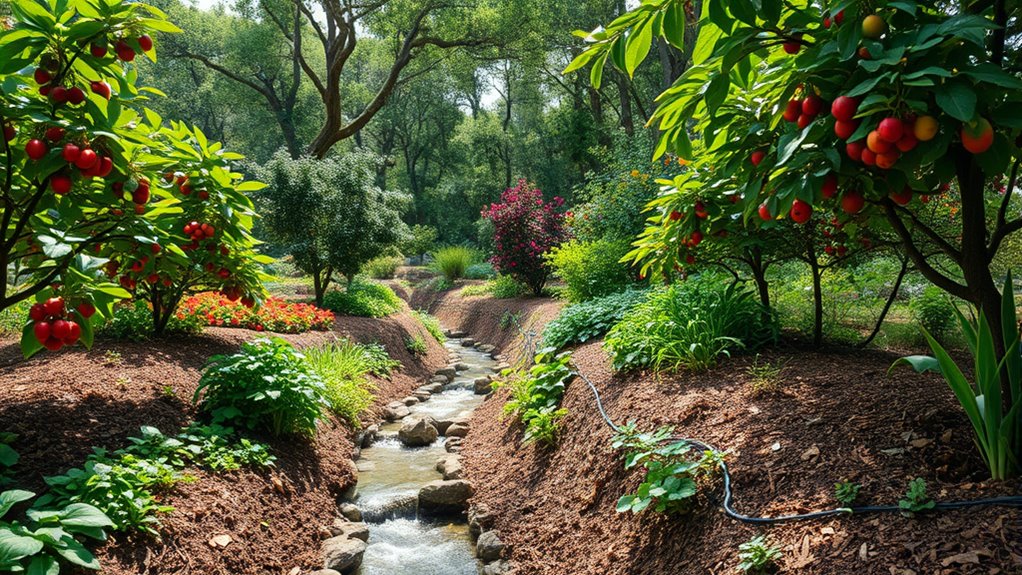
You can improve your food forest’s sustainability by capturing water efficiently and reducing runoff. Mulching helps retain soil moisture, making your system more resilient during dry periods. Designing contour swales directs water where it’s needed most, maximizing absorption and minimizing erosion.
Efficient Water Capture
How can food forest guilds effectively capture and utilize water to enhance sustainability? By implementing smart water management techniques, you can maximize efficiency and reduce waste. First, use rain harvesting systems to collect and store rainwater for dry periods. Second, install drip irrigation to deliver water directly to plant roots, minimizing runoff and evaporation. Third, design landscape contours and swales to direct excess water toward your plants and prevent erosion. Fourth, incorporate water catchment features like ponds or basins to slow runoff and promote groundwater recharge. These methods work together to create a resilient water system, ensuring your food forest remains productive even during droughts, while conserving resources and supporting long-term sustainability.
Mulching for Moisture
Mulching plays a vital role in maintaining soil moisture within food forest guilds, especially when integrated with other water management strategies. Applying organic mulch reduces evaporation, keeps roots cool, and promotes healthy soil structure. To maximize water retention, you can incorporate rainwater harvesting systems that direct water directly to your mulch layers. Imagine a garden where mulch, rain barrels, and edible fungi work together to create a resilient ecosystem.
| Mulch Layer | Water Strategy | Beneficial Organisms |
|---|---|---|
| Thick straw | Rainwater harvesting | Mycorrhizal fungi, fungi that break down mulch |
| Leaf litter | Retains moisture | Edible fungi for nutrition |
| Wood chips | Slow water loss | Beneficial bacteria |
| Compost on top | Nutrient retention | Soil microbes |
Contour Swales Design
Have you contemplated how contour swales can transform water flow across your food forest? They slow runoff, increase water infiltration, and support healthy perennial herbs. Properly designed swales follow natural land contours, directing excess water to areas needing moisture. This reduces erosion and promotes pest management by creating balanced moisture levels, which discourage pests and diseases.
Key points to consider:
- Place swales uphill of perennial herbs to ensure consistent hydration.
- Incorporate mulch on swale beds to enhance water retention.
- Use swales to channel water toward zones requiring irrigation.
- Plant beneficial cover crops in swale zones to further improve pest resistance.
Maintenance and Adaptation of Your Food Forest Guild
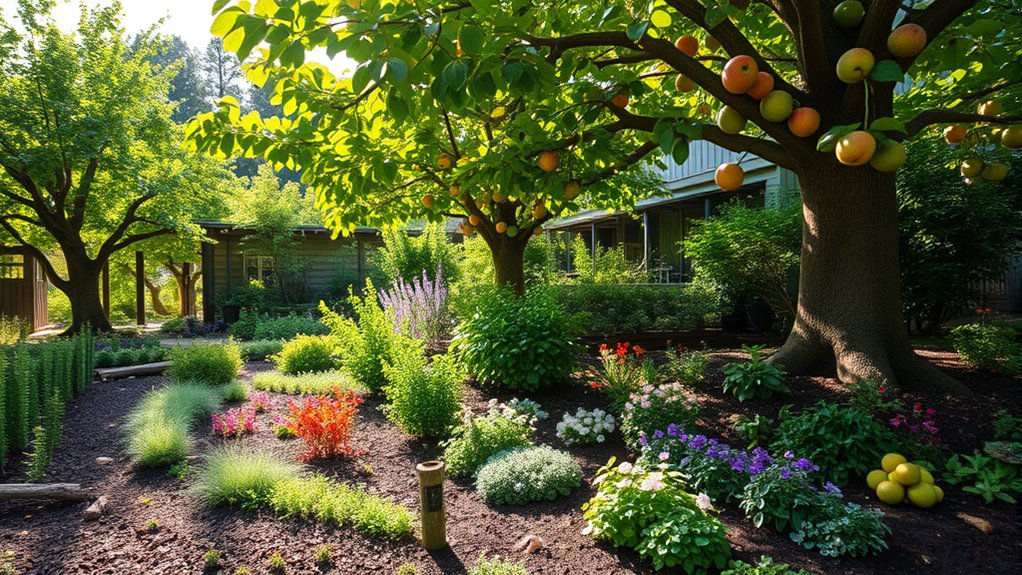
Maintaining and adapting your food forest guild is crucial to guarantee it remains productive and resilient over time. Regular pest management helps prevent infestations that can weaken plants and disrupt harmony. Use natural methods like encouraging beneficial insects and companion planting to keep pests in check. Additionally, plant propagation is essential for replacing or expanding your guild. Propagate new plants through cuttings, seeds, or division to maintain diversity and ensure continuous growth. Keep an eye on plant health, prune when necessary, and adjust plant placements based on growth patterns or changing conditions. Flexibility is key; adapt your strategies as your food forest evolves, ensuring it stays healthy, balanced, and self-sustaining for years to come.
Benefits of Embracing a Self-Sustaining Food System

Embracing a self-sustaining food system allows your food forest to flourish with minimal external input, reducing ongoing labor and resource costs. This approach boosts urban farming efforts by creating resilient, productive landscapes that require less maintenance. It also enhances your food sovereignty, giving you control over your food sources and reducing reliance on external supply chains.
A self-sustaining food system minimizes external input, boosting resilience, reducing costs, and empowering food sovereignty.
Here are some benefits:
- Increased resilience to climate and pest challenges, ensuring consistent harvests.
- Lower long-term costs through reduced need for fertilizers, pesticides, and water.
- Greater independence in food production, fostering community self-reliance.
- Environmental benefits like improved soil health and biodiversity, supporting sustainable urban farming.
Frequently Asked Questions
How Long Does It Take for a Food Forest Guild to Become Fully Productive?
The maturation timeline for a food forest guild varies, but you can expect it to take around 3 to 7 years to reach full productivity. During this period, you’ll see gradual increases in yield milestones as plants establish and ecosystems balance. Patience is key, since the initial years focus on plant growth and soil health, leading to a thriving, self-sustaining system that provides abundant harvests once fully developed.
Can Food Forest Guilds Be Adapted to Urban or Small-Scale Spaces?
Yes, you can adapt food forest guilds to urban or small spaces. Container gardening and balcony planting work well, allowing you to create mini guilds with layered plants. Use pots, raised beds, or vertical setups to mimic natural layers, maximizing space. Focus on selecting compact, productive plants that thrive in limited areas, and plan for diverse species that support each other, making your small-scale food forest both sustainable and abundant.
What Are Common Challenges Faced When Establishing a Food Forest Guild?
When establishing a food forest guild, you often face challenges like selecting the right plants and managing pests. You need to choose plants that work well together, considering soil, sunlight, and water needs. Pest management is essential; you must balance natural predators with plant health. These challenges require careful planning and patience, but with persistence, you’ll create a thriving, self-sustaining ecosystem.
How Do Food Forest Guilds Impact Local Biodiversity and Ecosystems?
While some worry about invasive species, food forest guilds often boost local biodiversity and ecosystems. You support pollinators by planting diverse flowers and trees, creating habitats that attract bees and butterflies. This diversity helps maintain ecological balance, reduce pest issues, and foster resilience. By intentionally designing guilds, you enhance ecosystem health, turning a simple garden into a thriving, self-sustaining habitat that benefits both native species and your environment.
Are There Specific Climate Zones Better Suited for Food Forest Guilds?
You should consider climate compatibility and soil preferences when determining if a climate zone suits food forest guilds. Some zones offer ideal conditions with suitable temperatures and rainfall, making it easier for plants to thrive. Additionally, understanding your soil type helps you select the right species and guild arrangements. Zones with stable climates and rich soils generally support more productive, resilient food forests, ensuring self-sustaining abundance over time.
Conclusion
By designing your food forest guild with resilience and balance, you create a self-sustaining oasis that needs less effort over time. Remember, a well-planned garden is like a good neighbor—mutually beneficial and thriving together. Embrace the process, stay adaptable, and enjoy the abundance that comes from working with nature’s rhythms. With patience and care, you’ll turn your patch into a thriving, sustainable paradise that keeps giving back.
